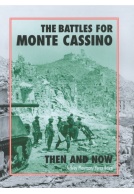German Breakthrough in Greece (Hardback)
The 1941 Battle of Pineios Gorge - Then and Now
Imprint: After the Battle
Series: Then and Now
Pages: 176
Illustrations: 184 mono illustrations
ISBN: 9781399079051
Published: 6th March 2025
(click here for international delivery rates)
Order within the next 9 hours, 10 minutes to get your order processed the next working day!
Need a currency converter? Check XE.com for live rates
On February 25, 1941 Winston Churchill, the British Prime Minister, made his first approach to the Australian and New Zealand governments seeking their approval for the use of their troops in his Greek venture. While the New Zealand government was adamant that their forces should have the support of an armoured brigade, the Australian government was more concerned that it would end in an evacuation, a fear also evident among the British planners, a view they were reluctant to share. Fast forward two months and it is now April 14. Ten days have passed since the German invasion of Greece and the Anzacs are in trouble, even if they don’t yet know it. The small German motorcycle battalion that has just reached the 21st NZ Battalion positions at Platamon is a harbinger of the panzer battle group yet to come. To the south is the strategic town of Larissa. North of it almost the entire Anzac Corps is spread out along the line of the Olympus mountains, with its western end anchored on Kalabaka, where a small brigade group waits for the appearance of the 1st Armoured Brigade further north. Larissa is their only escape route and the German thrust is aimed straight at it. Worse still, as the fighting intensified at Platamon, the Anzac Corps high command seemed slow to react and almost turned a blind eye to it as they continued to reinforce the west against what was only a perceived threat. That this lone battalion, with four 25-pounders in support, managed to hold off the attackers for as long as they did until Anzac Corps Headquarters finally reacted was certainly not due to the latter’s commander, Lieutenant General Thomas Blamey. There is a view in some quarter that this successful delaying action only became possible for the intervention of Blamey’s Chief-of-Staff, Brigadier Sydney Rowell. However, the complete evacuation of all Anzac troops north of Larissa may owe much more to the propensity of the New Zealand soldier for misappropriation of other people’s assets, in this case British anti-tank mines. In the end this situation was turned around thanks to the actions of small groups of men, whose resilience and resourcefulness, often under extreme circumstances, helped delay the advance. The Germans in turn made a number of blunders, not the least of which were logistic but it could also be put down to overconfidence on their part after their easy victories in France. In the end the entire Anzac Corps escaped the trap, albeit by the skin of their teeth, and the British avoided the wider political ramifications of what could have happened had they lost what was, in New Zealand’s case, their sole contribution to British land forces in the Middle East. Just how the Anzac troops in Greece succeeded in the face of what was thrown against them from both sides of the hill is the subject of this book.
His career as a biochemist is apparent in the meticulous way in which he writes, yet his style is eminently readable. Jeff is a good communicator... The book is highly recommended.
Wargamingnz
Read the full review here
"Jeffrey is clearly knowledgeable on this subject and his narrative, the useful maps and many photographs make for another excellent addition to the ATB series."
History Book Chat
Read the full review here
The whole story is heavily illustrated, and the photos, both archive and modern comparisons, all have comprehensive captions which add even more details for the story, plus helpful maps. The archive photos show some great detail on the early panzers, as well as a few unusual pictures of some Guy Quad gun tractors, knocked out and abandoned. A fascinating story and I have long been a fan of the Then & Now format of these books from After the Battle Publications. If you are holidaying in Greece, this gives a great guide for places to visit, and to retrace this story of a small part of the war in 1941.
Military Model Scene
Read the full review here




























